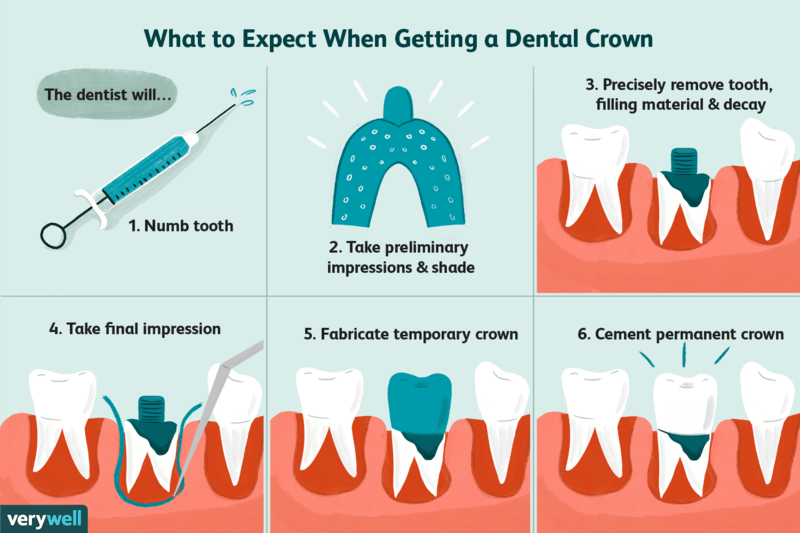
Dental crowns are the superheroes of dental care, providing strength, protection, and a beautiful smile when a tooth is damaged. Have you ever wondered how do dental crowns stay in place? This is primarily with the help of a dental cement, which bonds the crown to the prepared tooth. The tooth is first shaped and any decay is removed, and then the crown is securely attached with this special adhesive, creating a durable connection. This combination of natural adhesion and dental cement ensures the crown’s stability. The crown’s custom fit and shape also contribute to its ability to stay put. With good care and maintenance, dental crowns can last for many years, making them a reliable solution for damaged or weakened teeth.
:max_bytes(150000):strip_icc()/numbing-the-tooth-in-a-dental-crown-procedure-1059036_final-788dfa05acf24255aa0d406f45df1b31.png)
How Do Dental Crowns Stay in Place?
Dental crowns are a common dental restoration used to repair damaged or weakened teeth. They are designed to fit over the existing tooth structure, providing protection and restoring functionality. One question that often arises is how do dental crowns stay in place? In this article, we will explore the various methods used to secure dental crowns and ensure their long-term stability.
The Role of Dental Cement
Dental Cement: The Bonding Agent
Dental crowns are secured using dental cement, which acts as a strong adhesive. The cement seals the crown to the prepared tooth surface, preventing bacterial infiltration and further damage.
Types of cement can vary, with some requiring light curing and others being self-curing, all ensuring a strong bond.
Tooth Preparation: Creating a Stable Foundation
- Tooth preparation is essential to ensure a proper fit for the crown.
- A small amount of tooth structure is removed to make room for the crown, and additional materials like core buildup may be needed.
- This process creates a stable foundation for the crown, preventing movement and displacement.
Bonding Agents: Enhancing Stability
- Supplemental Stability: Bonding agents are employed in conjunction with dental cement to enhance the overall stability of dental crowns. While dental cement alone provides a strong bond, bonding agents add an extra layer of adhesive strength, further fortifying the connection between the crown and the prepared tooth.
- Application Process: These agents are applied to the tooth surface before the dental cement is placed. They create an adhesive foundation for the crown, ensuring that it remains firmly attached to the underlying tooth structure. The bonding agent essentially acts as an intermediary layer that enhances the bond between the tooth and the crown.
- Beneficial for Compromised Teeth: Bonding agents are particularly advantageous when the natural tooth structure is compromised or weakened. In situations involving significant tooth decay, fractures, or previous dental work, the additional adhesive strength provided by bonding agents helps to secure the crown effectively. This is essential in cases where the tooth may not have the ideal structural integrity to support the crown on its own, allowing for a more durable and long-lasting restoration.
Proper Maintenance and Care
- Regular Oral Hygiene Practices: Maintaining good oral hygiene is vital to the stability of dental crowns. Brushing and flossing help prevent the accumulation of plaque and bacteria around the crown’s margins, reducing the risk of gum inflammation and decay. Proper hygiene preserves the integrity of the tooth and surrounding tissues, ensuring the long-term success of the crown.
- Routine Dental Check-ups: Regular dental check-ups are essential for monitoring the condition of the crown and assessing overall oral health. Dentists can identify any issues with the crown, such as signs of wear, cracks, or loose edges. Timely detection allows for necessary adjustments or repairs, preventing more extensive problems.
- Avoiding Harmful Behaviors: To maintain the stability of a dental crown, it’s crucial to avoid behaviors that could stress or damage it. Biting down on hard objects like ice, pencils, or using teeth as tools can exert excessive force on the crown, potentially causing it to dislodge or become damaged. By refraining from these habits, you help protect the crown’s longevity.
- Professional Dental Care for Loose Crowns: If a dental crown becomes loose or dislodged, it’s imperative to seek immediate professional dental care. Dentists have the expertise and tools to assess the situation, reattach or replace the crown, and ensure it fits securely. Attempting self-repair may lead to further damage, jeopardizing the long-term stability and success of the restoration.
In conclusion, dental crowns stay in place through the use of dental cement, proper tooth preparation, bonding agents, and regular maintenance. These factors work together to create a secure and stable restoration that can withstand the pressures of daily use. By understanding how dental crowns stay in place, patients can feel confident in the longevity and functionality of their dental restorations.
Key Takeaways: How Do Dental Crowns Stay in Place?
- Dental crowns are held in place using dental cement or adhesive.
- The tooth is prepared by removing any decay and shaping it to fit the crown.
- The crown is custom-made to fit the patient’s tooth and bite.
- Once placed, the crown covers the entire visible portion of the tooth, protecting it and restoring its function.
- With proper care and regular dental check-ups, dental crowns can last for many years.
Frequently Asked Questions
How do dental crowns stay in place?
Dental crowns are designed to stay securely in place to ensure their longevity and effectiveness. There are several factors that contribute to the stability of dental crowns:
1. Fit and shape: Dental crowns are custom-made to fit your tooth precisely. Before placing the crown, the dentist will reshape the tooth to create a stable foundation. The crown is then crafted to match the shape and size of the prepared tooth, allowing it to fit snugly and securely.
2. Cementing: Dental crowns are typically cemented onto the tooth to hold them in place. The dentist will use a dental adhesive or resin cement to bond the crown to the tooth structure. This cement creates a strong bond between the crown and the tooth, ensuring its stability.
3. Dental bonding: In some cases, dental crowns may be bonded to the adjacent teeth for additional support. This is especially common when replacing missing teeth with dental bridges, where the crowns on either side of the gap are attached to the natural teeth on either side.
Can dental crowns come loose?
While dental crowns are designed to stay in place, there are instances where they may come loose. Here are a few reasons why this can happen:
1. Decay or damage: If the underlying tooth structure becomes decayed or damaged, it can weaken the bond between the crown and the tooth. This can result in the crown becoming loose or even falling off.
2. Poor oral hygiene: Inadequate oral hygiene can lead to gum disease or tooth decay, both of which can compromise the stability of dental crowns. It is important to maintain good oral hygiene practices, including regular brushing, flossing, and dental check-ups.
3. Teeth grinding or clenching: Habitual teeth grinding or clenching, also known as bruxism, can put excessive pressure on dental crowns. Over time, this can cause the crown to loosen or even crack. Wearing a nightguard can help protect the crown from the effects of bruxism.
Do dental crowns ever need to be replaced?
In general, dental crowns are designed to be durable and long-lasting. However, there are situations where a dental crown may need to be replaced:
1. Decay or damage: If the underlying tooth structure becomes decayed or damaged, it may compromise the integrity of the crown. In such cases, the crown may need to be replaced to restore the tooth’s function and aesthetics.
2. Wear and tear: Over time, dental crowns can experience normal wear and tear. This can include chipping, cracking, or the wearing down of the crown’s surface. If the crown becomes significantly worn or damaged, it may need to be replaced.
3. Aesthetics: As dental technology advances, newer and more natural-looking materials may become available. If a patient desires a more aesthetically pleasing crown, they may choose to have their existing crown replaced with a newer version.
Can dental crowns be repaired if they become damaged?
In some cases, dental crowns can be repaired if they become damaged. The extent and type of damage will determine whether repair is possible. Minor chips or cracks can often be repaired using dental bonding materials.
However, if the damage is extensive or compromises the structural integrity of the crown, replacement may be necessary. It is best to consult with your dentist to determine the most appropriate course of action for repairing a damaged dental crown.
How long do dental crowns typically last?
The lifespan of dental crowns can vary depending on various factors, including the materials used, oral hygiene practices, and the individual’s habits. On average, dental crowns can last between 10 to 15 years.
Proper oral hygiene, including regular brushing, flossing, and dental check-ups, can help prolong the lifespan of dental crowns. Avoiding habits such as teeth grinding or clenching can also help prevent premature wear or damage to the crown.
It is important to note that individual experiences may vary, and some dental crowns may last longer or require replacement sooner. Regular dental examinations can help monitor the condition of dental crowns and ensure timely intervention if necessary.
Dental Crown Procedure
Final Summary: How Do Dental Crowns Stay in Place?
Dental crowns stay securely in place through a combination of factors. Firstly, proper tooth preparation is crucial. This involves removing decay or damage and shaping the tooth to create a solid foundation for the crown. An incredibly strong adhesive material is then used to bond the crown to the tooth structure, ensuring it remains firmly in place, even with regular biting forces.
Furthermore, dental crowns leverage the natural anatomy of your teeth for stability. They are custom-designed to fit snugly over the prepared tooth, offering protection against further damage. The crown’s shape and contours help distribute chewing forces, reducing stress on the underlying tooth structure.
In essence, the stability of dental crowns is achieved through a blend of tooth preparation, adhesive bonding, and consideration of natural tooth anatomy. This knowledge can provide confidence when undergoing a dental crown procedure.
Call or Book appointment online
:Ace Dental Care Alpharetta office: 678-562-1555 - Book Now
Ace Dental Care Norcross office: 770-806-1255 - Book Now
Disclaimer
This blog post was generated by artificial intelligence. The content of this post may not be accurate or complete, and should not be relied upon as a substitute for professional advice. If you have any questions about the content of this post, please contact us.
We are constantly working to improve the accuracy and quality of our AI-generated content. However, there may still be errors or inaccuracies. We apologize for any inconvenience this may cause.





